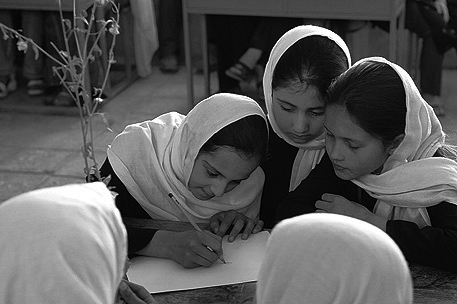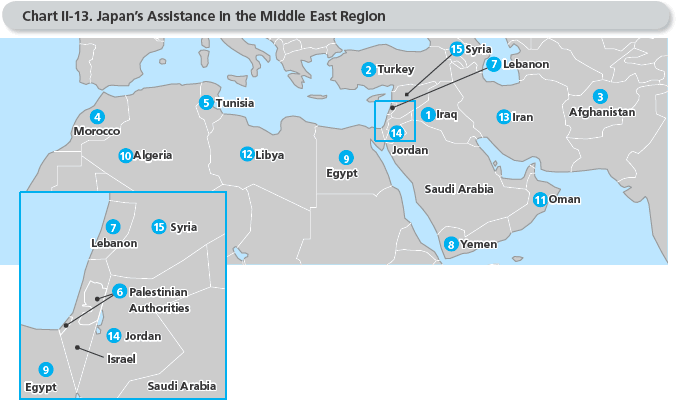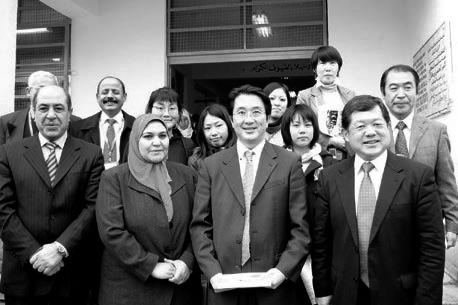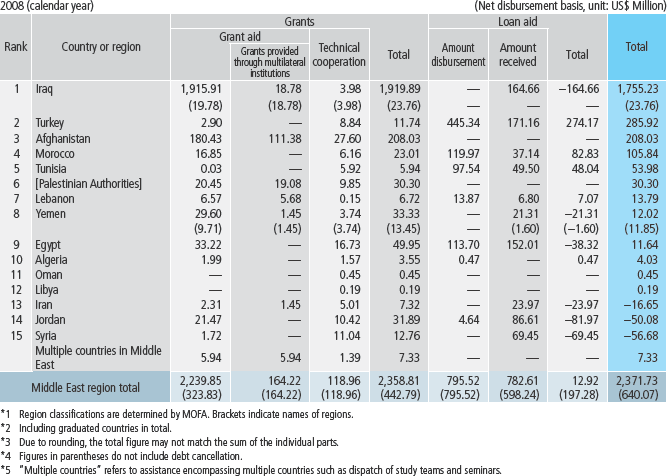Japan's Official Development Assistance White Paper 2009
5. Middle East
•Approximately US$2,371.73 million (approximately US$3,154.33 million)
•Approximately 34.2% of total bilateral aid (approximately 21.2%)
The Middle East is the world's major energy supplying region, providing nearly 90% of Japan's imported crude oil. Peace and stability of the Middle East is an important issue that might directly affect the peace and prosperity of the international community as a whole including Japan. Therefore, the reconstruction of Iraq and Afghanistan as well as the progress in the Middle East peace process are of tremendous importance. Japan aims to construct multi-layered partnerships centered around the private sector, utilizing ODA and other public funding.
As the Middle East includes high-income oil-producing countries as well as least developed countries (LDC) the economic situation of each country is diverse. While tasks such as socioeconomic infrastructure development and poverty countermeasures are vital in low- and mid-income countries, oil-producing nations that have graduated from the need for ODA possess other issues such as human resource development.
<Japan's Efforts>
Japan attaches great importance to the Middle East with regards to achieving "human security" and "peace building"—which are basic principles and priority issues, respectively, of Japan's ODA Charter—and securing resources and energy. Japan contributes to the social stability and economic development of the Middle East by working together with the international community to focus assistance on sectors such as water resource management, infrastructure development, and human resource development.
Japan's proactive support for Iraq includes assistance of a maximum US$5 billion in ODA and approximately US$6.7 billion in debt relief. As for Afghanistan, at the International Conference in Support of Afghanistan (Paris Conference) in June 2008, Japan pledged an additional US$550 million, which has made the aggregate total of pledged donations reach US$2 billion. In addition, in March 2009, nearly US$300 million in funds was provided as necessary assistance to successfully implement the August 2009 presidential election.
•See Part II, Chapter 2, Section 1 for more information on assistance to Afghanistan.
Japan's support for Middle East peace has included approximately more than US$1 billion in assistance to the Palestinians provided since 1993. Recognizing the importance of realizing peace through the establishment of a Palestinian state (the two-state solution) which could maintain coexistence and co-prosperity with Israel, Japan has provided consistent support to the peace efforts of President Mahmoud Abbas of the Palestinian Authority (PA). As part of these undertakings in recent years, efforts have been made to realize the "Corridor for Peace and Prosperity"(Note 43) initiative with the participation of Israel, PA, and Jordan.
Notes:
(43) This is an attempt to develop the Jordan Valley through intraregional cooperation between Japan, Palestine, Israel, and Jordan via unique Japanese mid- to long-term undertakings aimed at the coexistence and prosperity between Israel and Palestine. Currently, efforts are being made to plan the construction of a processed agriculture complex in the outskirts of Jericho.
Strengthening of Teacher Education Program (Afghanistan)
In Afghanistan, the number of students in elementary and middle schools is rapidly increasing, as children that were once unable to attend school under the Taliban regime are now able to attend. Accordingly, the number of teachers is also significantly increasing, but there are still many teachers that enter the classroom without having received adequate training. Thereupon, Japan is assisting in creating instruction manuals for teachers that teach subjects for first to sixth graders. These manuals provide concrete explanations on teaching methods and are created so that teachers can promptly employ them in classes. Manuals are currently distributed to schools throughout Afghanistan and teacher training is also being conducted. Also, partnerships with other donors and NGOs allow for distributing the manuals and providing training in a wider range of areas. These manuals are anticipated to lead to higher quality classes.

Children observing plants in a group study (Photo: JICA)


State Secretary for Foreign Affairs Koichi Takemasa with associates of the United Nations Relief and Works Agency for Palestine Refugees in the Near East (UNRWA) and Japanese associates doing activities in the field (at Palestinian refugee camp) (Photo: JICA)

